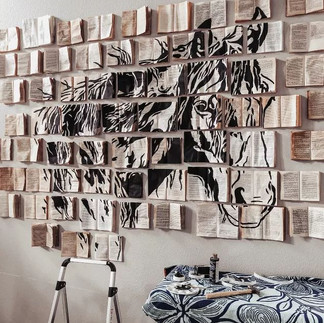Repurposing Old Books for Unique Art
If you’re looking to add a vintage flair or unique textures to your art, old books can be an incredible resource. Whether you’re painting, collaging, or printmaking, these treasures offer endless possibilities. And the best part? You don’t have to break the bank to get your hands on them. Here’s how you can find old books for free or cheaply, and some creative ways to incorporate them into your artwork.

Where to Find Old Books
Library Sales and Book Exchanges: Libraries often hold sales to clear out older or duplicate books. These sales can be a goldmine for artists. You can usually find books for just a few dollars, or even less. Some libraries also have book exchange programs where you can trade in your old books for new ones. If you’re lucky, you might stumble upon some beautifully aged books with interesting covers or unique typography that can add character to your art.
Thrift Stores and Garage Sales: Thrift stores and garage sales are excellent places to find inexpensive old books. These venues often have a wide range of books, from vintage classics to obscure titles, all at bargain prices. Keep an eye out for sales in your area, especially estate sales, where you might find entire collections of books being sold for pennies. The randomness of these finds can be inspiring in itself—sometimes a book you never would have chosen otherwise can spark a whole new direction in your work.
Freecycle and Online Marketplaces: Websites like Freecycle, Craigslist, and Facebook Marketplace often have listings for free or very cheap books. People are often eager to give away books they no longer need, and you can score some great finds by keeping an eye on these platforms. Don’t be shy about asking for specific types of books, either—people may be willing to give you exactly what you’re looking for if they know it’s for a creative project.
Ask Friends and Family: Sometimes, the best finds are closer than you think. Let friends and family know you’re looking for old books, and you might be surprised by how many are willing to part with their collections. Often, people hold onto books out of nostalgia but are happy to see them go to a good home where they’ll be put to creative use.
Creative Ways to Use Old Books in Your Art
Collage Elements: Old book pages, especially those with yellowed edges or interesting fonts, make fantastic collage elements. Tear or cut them into shapes, layer them with other materials, or use them as backgrounds for your mixed media projects. The text can add an intriguing narrative element to your work, and the aged paper offers a texture that’s difficult to replicate with newer materials.
Try combining pages from different genres—poetry, textbooks, novels—to create a layered, multifaceted piece.

Paper for Printmaking: If you’re into printmaking, try using pages from old books as your printing surface. The aged paper can create a unique texture and absorb ink differently than standard printmaking paper. Experiment with different types of book paper to see how they interact with your printing techniques.
For example, pages from an old encyclopedia might offer a smooth, glossy finish, while a worn-out novel’s pages could give you a rougher, more textured result. Mixing and matching can lead to exciting discoveries.
Incorporating Text in Paintings: For painters, integrating text into your work can add depth and meaning. You can adhere pages directly to your canvas using acrylic medium, then paint over or around the text.
This method allows the words to peek through your paint layers, adding an extra layer of complexity to your piece. The juxtaposition of visual and textual elements can create intriguing contrasts or reinforce the themes of your work. Try using specific passages or quotes that resonate with your artistic vision.
Creating Unique Book Art: Instead of using the pages, consider using the entire book as your canvas. You can paint directly on the cover or inside the book, turning it into a unique art object. For a 3D effect, cut into the pages to create depth, or fold them to form shapes that complement your artwork. This method allows you to experiment with sculptural techniques, transforming the book into a piece of art in itself.
If you enjoy mixed media, you can combine paint, ink, and even small objects to make each book a truly one-of-a-kind creation.
Handmade Journals and Sketchbooks: Old book covers can be repurposed into the covers for handmade journals or sketchbooks. Remove the original pages and replace them with blank or mixed media paper, creating a personalized art journal with a vintage touch.
You can also leave some of the original pages in the journal as a source of inspiration or as prompts for future artwork. These handmade journals make wonderful gifts or can become a cherished space for your own artistic explorations.

Final Thoughts
Old books offer more than just reading material—they can be an endless source of inspiration and materials for your artwork. Knowing where to find them and how to incorporate them creatively allows you to add a unique, historical element to your art without spending a fortune. Whether you’re using them for collage, printmaking, painting, or creating something entirely new, old books bring a sense of history and depth to your work that’s hard to replicate with new materials.
So, start hunting for those hidden gems and see how they can transform your work! And remember, the beauty of art is in experimentation—don’t be afraid to try out different techniques and see what resonates with you.
Be sure to share your old book art projects with us—we’d love to see how you’re using these tips in your work. Whether it’s a small detail or the centerpiece of your piece, old books can bring a new level of creativity to your art.
See you in the studio!



















Comments